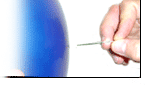Egg In a Bottle
Here's an amazing way to get a hard-boiled egg into a bottle, even though the
mouth of the bottle is smaller than the egg! What's more, you don't even need to
touch the egg to get it to go in!
For this experiment you will need:
• a hard-boiled egg
• a glass bottle with a mouth just slightly smaller than the egg (a
fruit-drink bottle works well)
• a 8-cm by 8-cm (3-inch by 3-inch) piece of newspaper
• a match
Remove the shell from the egg. Set the egg on the mouth of the bottle to see
that the egg does not fit through the mouth.
Fold the piece of newspaper into a strip that can be dropped into the bottle,
about 1 cm by 8 cm.
Light the match and use it to ignite the folded strip of paper. Remove the
egg from the mouth of the bottle and drop the burning strip of paper into the
bottle. Before the fire goes out, set the egg back onto the mouth of the bottle.
Within a few seconds the egg will squeeze through the mouth and into the
bottle.
As it entered the bottle, the egg may have broken into pieces. This happens
when the diameter of the egg is more than about 0.5 cm (about 3/16 inch) larger
than the diameter of the bottle's opening. A medium or small egg may be small
enough to enter the bottle without breaking. Also, rubbing some cooking oil onto
the mouth of the bottle will make it easier for the egg to slide into the bottle
without breaking.
A similar effect can be produced using a water-filled balloon in place of an
egg. Just pour water into a round balloon to fill it without stretching it, then
tie it shut. When the filled balloon is the size of an egg, it can be used in
the same way as the hard-boiled egg.
Why does the egg slide into the bottle, even though no one is pushing it?
Because the pressure of the air is pushing it. Before the burning paper was put
into the bottle, the pressure of the air inside the bottle was the same as
outside the bottle. The burning paper, however, heats the air inside the bottle.
This causes the air inside to expand. When the egg is placed on top of the
bottle, it seals the bottle, and the fire eventually goes out. When the fire
goes out, the air inside the bottle cools. As it cools, the air contracts, and
the pressure of the air inside the bottle becomes less than the pressure
outside. Then, the higher outside pressure pushes the egg into the bottle!











